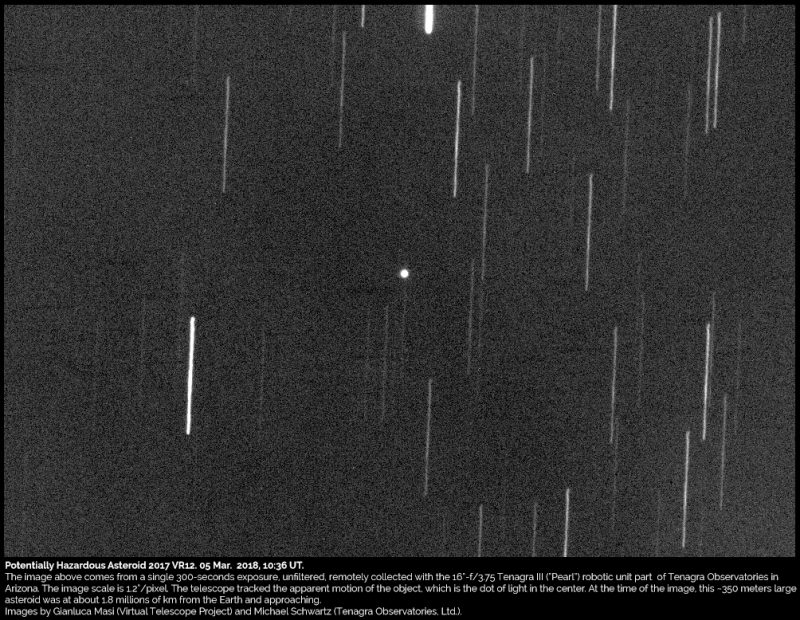Gianluca Masi of Virtual Telescope Project emailed late Tuesday, saying:
This morning, our live streaming coverage of asteroid 2017 VR12 was amazing.
He included a link to the video above, which is made from 240 images of the asteroid, all taken on March 7, 2018, from 09:50 to 11:52 UTC, just a few hours past the asteroid’s closest approach to Earth of 3.76 lunar-distances. He wrote:
As 122 minutes are shown in 0.25 minutes, this video is showing the asteroid moving about 500 times faster than in reality.
Asteroid 2017 VR12 was closest to Earth at around 07:53 UTC (2:53 a.m. EST; translate UTC to your time) on March 7.

Amateur astronomers also picked up this asteroid with backyard telescopes. See Brian Ottum’s video below.
Professional astronomers have been following 2017 VR12 since it was discovered on November 10, 2017, by the 60-inch Pan-STARRS 1 telescope in Hawaii. NASA’s Goldstone Radar in California was beaming radar signals at the asteroid, and recording those that bounce off it, between March 5 and 7. Radar can show scientists the shape and rotation of the space rock. We haven’t seen any radar images of the asteroid released yet, but will post them in this article if we see them.
This asteroid is supposed to be a good radar target for professional astronomers, because of its relatively large size.
Asteroid 2017 VR12 is estimated to be between 820 to 919 feet (250 to 280 meters) in diameter. That’s in contrast to 65 feet (20 meters) for the space rock that came closer and exploded in the atmosphere over the Russian city of Chelyabinsk five years ago. And it’s in contrast to an estimated 150 feet (46 meters) for the space rock that caused a .75-mile-wide (1.2-km-wide) crater near Flagstaff, Arizona, some 50,000 years ago.
Asteroid 2017 VR12 offers no risk to Earth this time, however.
Calculations show this space rock will come no closer for at least the next 177 years than it did on March 7.
Because it has the potential to make close approaches to Earth and is big enough to cause significant regional damage if it were to strike, 2017 VR12 is classified as a Potentially Hazardous Asteroid by the Minor Planet Center.
As asteroids go, asteroid 2017 VR12 is considered medium-sized. Ceres, the largest asteroid (now classified as a dwarf planet), is 588 miles (946 km) in diameter (but objects the size of Ceres stay in the asteroid belt, far from Earth).

Bottom line: 2017 VR12 passed closest to Earth – 3.76 times the moon’s distance – on March 7, 2018. Images and video in this post.











